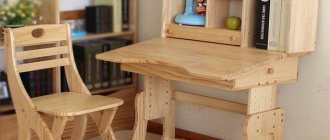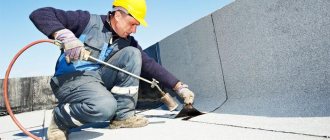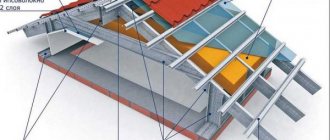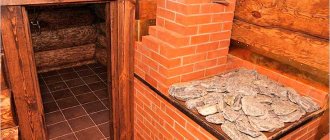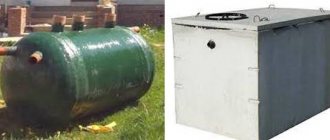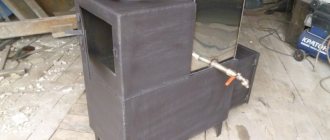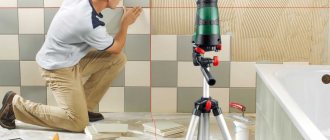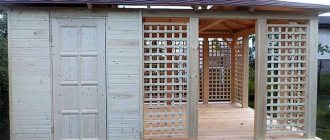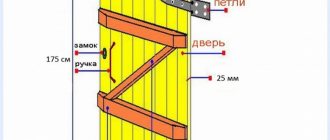Published: 21.01.2019 /
Comments: No comments /
Category:Bathhouse projects
As practice shows, many standard designs of modern baths, although they have a lot of advantages, have one significant drawback: they are unified and designed for standard areas. We were given a completely different task - to design an object that could fit organically into a narrow area. We’ll tell you right now how we dealt with this basic customer requirement.
We made the structure itself minimal in width and at the same time quite long. This approach made it possible to achieve a fairly large size of the structure - the total area of the bathhouse complex was 77.66 square meters. m., and at the same time leave enough space on the territory for other buildings and the organization of open locations for various purposes.
In addition, according to the project, our narrow bathhouse was located almost close to the fence, which means we were able to avoid dividing the site into separate zones.
What is important to note right away
The final stage of construction is the construction of the roof.
However, even at the design stage, it was preceded by many calculations designed to guarantee in the future the ability of this roof to withstand wind, snow, condensation and other inevitable misfortunes. We remind you of this so that the reader who intends to do the roofing with his own hands soberly assesses his skills and gives the calculations to professionals, if he is not an architect or civil engineer . It’s easier to collect according to calculations. Perhaps this is the best option for those who are determined to build themselves.
Engineering formulas cannot be called simple. Simplified versions can be found in books on roofing, but even they are very cumbersome.
Therefore, we will limit ourselves to a rather superficial description of the available types of bathhouse roofs. In the text you will find links to other materials where the issue raised is discussed in much more detail than in this review.
Devices and structures
There are several types of roof structures for a bathhouse . Of course, they are universal, not only intended for her, but the important thing is that they are all suitable, and the choice is only up to the designer.
Height: bathhouse with a low, flat roof - photo
However, we will not start with the structure, but with a parameter that is variable for most structures - the height or angle of the roof.
Bathhouse with a flat roof, terrace and relaxation room. Photo StroyDom
A bathhouse with a flat roof is when the roof slope does not exceed 2.5 degrees. This is the official formulation, and the fact that they sometimes say that slopes up to 10 degrees are considered flat is incorrect, because from 2.5 and somewhere up to 20 degrees (and maybe up to 30) these are bathhouses with a low roof.
IMPORTANT! 30 degrees is the slope at which the snow mass exerts maximum pressure on the roof.
Yes, the angle of the roof is not a whim of the architect, but an optimization between the effects of wind and snow . Snow slides off the roof on its own, the slope of which is 45 degrees or higher.
BY THE WAY! The maximum slope is 60 degrees; they don’t do it anymore or do it in some special cases.
But the steeper the roof, the stronger it resists the wind that tries to tear it off. So it is customary to take into account in the calculations the average indicators characteristic of a given area. You can find them on specialized maps, which you will find in our other articles, for example, here.
Varieties of lean-to: photo
Bathhouse with a pitched roof. Photo StroyDom
Now let's move on to the structures. If the roof is not flat, then it has a slope. If there is one slope, it is single-pitch, if there are two, it is gable, and if there are four, it is hip. In addition to this, there is also a broken line - this is when there is an additional edge on the slope that sharply changes the angle of the slope.
So, what can we say about the types of pitched roofs for bathhouses? Three things can vary:
- tilt height;
- method of lifting a ridge wall;
- pediment bookmarks.
In addition, shed roofs provide the opportunity without an attic , that is, without overlapping, but this is acceptable for low roofs and buildings where the geometry of the ceilings is not particularly important.
Let me explain. The height of the slope indirectly affects whether there will be a ceiling or not; it becomes necessary if the slope is steep (more than 30 degrees).
A pitched roof is formed by the difference in height between two parallel walls on which the rafters are laid. In this case, you can build walls of the same height, and then build one of them.
Pediments are side walls that run along the top in an angle. This corner can be sealed in different ways. You can make a frame from bars, and then cover it with boards. Or you can use wall material.
You will find the nuances of the design, calculation and independent construction of this type of roof in this article.
Gable
This is the most common design, which can be implemented in two different rafter systems: layered or hanging. There is also a third option: traditional Russian roofing for a log house , in which the male pediments are the support for the slabs (“ribs”, which in this case are perpendicular to the usual rafters). This method is visible in the photo above.
Layered rafters have two main points of support - the ridge and the upper frame of the walls, but if they are more than 4.5 meters in length, then additional supports are made - struts and racks. The ridge is the highest line of the roof, the point where it bends. The ridge is a strong beam resting on the top of the pediment (also called a “gable”). The top frame of the walls is a beam around the perimeter of the top of the walls, made of wood, even if the house is brick or block.
Hanging rafters are a spacer structure, which means the following: the tops of the rafters above the ridge rest against each other, which causes spacer stress, which must be transmitted to the walls, trying to “push” them in different directions. To compensate for this tension, the bottoms of the rafter legs are tightened with a tie.
an attic , regardless of the angle of inclination, but it can be cold or warm. The latter is usually used for residential premises.
Hip (hatched)
What happens if you get rid of the gables on the sides of the pitched walls? The result will be a new design, in which there will already be four slopes , two of which will have a triangular shape, and two will have a trapezoidal shape. Look at the picture below to get an idea of what a bathhouse with a hip roof from above:
The rafter system of this roof is more complex than a pitched one, because the ridge does not have the ability to transfer the load to the gables (after all, there are none), so the ridge rests on supports with struts , and the supports are attached to a wooden beam, which is called a bench and is located on the top of the internal partition wall . Accordingly, the need for this wall dictates its limitations in the layout of the bathhouse.
This is what the rafter system of a hipped roof looks like from above:
Please note that part of the rafters is not directly connected to the ridge.
Broken (attic)
Mansard roof on the bathhouse.
At first, the architects realized that the attic could well be residential, and then they began to look for a way to increase its usable space , because the angle of inclination of a conventional roof implies large areas with a small height that cannot be used for housing. This is how a broken roof appeared with additional ribs on the slope, which change the rather moderate slope of the upper part to the steep angle of the lower part.
The roof structure of a bathhouse with an attic is a complicated version of a gable roof, but there are also significant differences: it has a ridge, but it will not be supported by pediments, because the pediment parts of a bathhouse with a sloping roof are built up and sewn up in the same way as we described this process for pitched roof. That is, the second floor may not be made from the wall material of the first.
The ridge rests on a post that has support in a transverse beam, which transfers the load to two more posts, and those to the interfloor ceiling . The end of the upper rafters is connected to the top of the lower ones, it pushes them apart, but the bottoms of the lower rafters are fixed to the floor beams.
IMPORTANT! If you are interested in approximate calculations for each of the listed roofs, go to this site, there are calculators for such calculations.
Installation
Construction of a roof is a technically complex process, so when building with your own hands, it is important to thoroughly follow the recommended technology. Installation work is carried out in dry weather to keep the rafter frame elements dry. The tools you will need are a grinder, a jigsaw, a screwdriver, a drill, and a construction stapler. Assembly is performed in the following order:
- First of all, the walls on which the Mauerlat is laid are waterproofed with roofing felt, folded 2-3 times. In the Mauerlat beam, the holes for fastenings are extended. Metal studs or anchor bolts are used as fasteners. If the log house of the bathhouse is made of logs or timber, the Mauerlat is replaced by the upper crowns, which are strengthened together with metal brackets.
- The assembly of the roof trusses begins. The legs are fastened together using a metal plate, checking the angle between them according to the level, and nailing down the tie. First of all, the outer trusses are installed, nailed to the Mauerlat. A rope is pulled between them, along which you can easily check the correct location of the remaining trusses. To ensure that the structure maintains its vertical position until the sheathing is installed, it is supported with temporary slopes.
Important! Since the bathhouse requires the presence of a heating device, the final stage of roof construction is the removal of the chimney pipe. It should be located at a distance of 30-50 cm from the ridge and rise above it by 50-100 cm.
Wall material options
In principle, we can immediately say that no wall material imposes large restrictions on the choice of the type of bathhouse roof . There are, of course, some features, which we will briefly discuss below.
Roofs of frame baths
The main condition for the roof of a frame bath is that it must be light. the frame itself is a rather flimsy structure. If there is any doubt about whether the frame will withstand the load (the weight of the roof plus the weight of snow typical for your region), it is better to recalculate it once again.
If a system of layered rafters is used, the beam of the upper wall trim becomes the support of the rafter legs . The hanging rafters also rest on it.
You should also choose the lightest options from roofing materials
From timber/logs
Firstly, the roof of a bathhouse made of timber/logs can be traditional, that is, with a rafterless system consisting of males, slats and laths. This is its characteristic feature, which is unlikely to be transposed onto buildings made of other wall materials.
Secondly, all other options for roofs on the bathhouse are also suitable here.
So there is one more choice than for other materials. Walls made of wood are strong and strong, but they have a peculiarity: they shrink strongly for a long time, and then continue to change dimensions until the end of their days.
IMPORTANT! For this reason, roof fastenings on a wooden structure should be made movable.
From blocks
Block materials include not only the familiar light blocks of foam concrete or aerated concrete and dark cinder blocks. Brick also applies here.
From foam blocks or gas blocks
For these types of block materials, an important point will be their waterproofing. But that's the first thing. Secondly, they do not hold fasteners well.
Gable roof for a bathhouse made of blocks (gas blocks). Photo StroyDom
There are no restrictions on the type of roof you can choose, but remember that you will have to waterproof not only the wood, but also the walls.
Gable roof on a bathhouse made of foam blocks. Photo StroyDom
As for the fasteners, you will need to make a high-quality reinforced concrete belt, and this will already hold your Mauerlat to which the rafters are attached. We saw how the Mauerlat is attached directly to the blocks, but there was just an extension to the house, which, apparently, is not particularly a pity.
Roof of a brick bath
Since brick is a durable material, the roof can be heavy; you can make a solid hip roof, for example. Likewise, there is no reason to limit your choice to lightweight roofing materials.
Multi-pitched roof of a brick bathhouse with a workshop, garage, boiler room, open and closed terrace. Teplokrepost Photos
To fasten rafters on brick walls, a reinforced belt is also first made, then a Mauerlat is placed on it and secured. And then the rafters are attached to the mauerlat. In areas with strong winds, the fastenings should be made a little mobile, for example, sliding.
Video description
The video discusses the waterproofing of a flat garage roof using rolled roofing materials:
See also: Catalog of companies that specialize in the construction of bathhouses.
Flat roof + corrugated sheeting
Another option for covering a flat roof. This is everyone's favorite corrugated sheet. This roofing material is produced by manufacturers in lengths from half a meter to 13 m. It has become possible to cover the roof of a building in a seamless way, meaning without transverse seams. And this guarantees one hundred percent protection against leakage, which is very important for flat roofing structures.
Flat roofing made of corrugated sheets Source himcomp.ru
The only requirement is to use profiled sheets with a profile height of at least 44 mm and a sheet thickness of at least 0.5 mm. The thing is that a flat roof is subjected to serious snow loads; a non-durable profiled material may not withstand them.
The corrugated sheeting can be laid directly on the concrete screed, secured to it with metal dowels. Or a sheathing of 100 mm wide boards is laid under it, which are attached to the concrete base with self-tapping screws and plastic dowels.
Installation of corrugated sheeting on a flat roof Source primezona.ru
Types of bathhouse roofs: photos
In addition to the situation when only she is under the roof of the bathhouse, there are also numerous options for combining it with various other buildings , which will become extensions.
Baths with barbecue
The barbecue area is the place where the meat is cooked. A summer kitchen is a place where anything can be prepared. The bathhouse can be combined with both.
You can read about the possible options for attaching this zone to a bathhouse in this article.
However, here we are talking mainly about the types of roofs over the bathhouse, so the options for roofing a bathhouse with a barbecue are either an extended roof , for example, increased roof overhangs, the ends of which have supports, while the angle of inclination of the slope is maintained, or it is an attached roof , in which the angle of inclination usually less steep than the main roof.
Bathhouse with barbecue under a gable roof. Photo by Uralekodom
The first option is suitable for creating a canopy under any of the slopes (the roof can be of any design). It is desirable that its implementation be included in the project and carried out during the construction of the bathhouse.
The second option is even more free in execution, because it can be carried out at any time after the completion of the construction of the bathhouse, it is not connected to the main rafter system and has no restrictions on the angle of inclination.
With attic
We have already said above that the sloping roof was invented in order to increase the usable area of the attic, which was turned into a living space. However, you should not think that this is the only option. In the same way, you can make a regular gable roof supported by gables , where the living space will be (in frontal projection) a hexagon inscribed in the roof triangle.
inside a hip roof, but this will significantly complicate the design of the rafters; this can no longer be done on your own (unless you are an architect, of course). As an option, it is possible to create a half-hip roof with an attic inside.
With utility room/shed and toilet under one roof
Perhaps a utility block and a bathhouse under one roof is the most common solution. The barn will not be as pitiful as the house if the bathhouse burns down.
At the same time, a bathhouse with a utility unit under one roof is also often made from different wall materials . This is understandable - there is no point in spending money on high-quality materials for a shed. But if the strength characteristics of the wall material of the bathhouse and the barn differ significantly, then the question of a single roof may be called into question.
Gable roof of a bathhouse with a shed + porch, hallway and recreation room. Photo StroyDom
Because a flimsy barn needs a lighter roof, and a bathhouse, say, made of timber, needs a more solid, warmer one. Therefore, the rafter system of the bathhouse may not extend to the barn, which will have its own. In this case, the overall unity will be maintained due to the roofing material, but there are limitations - it must be light and not require heavy continuous sheathing. Some kind of metal tile would be the best solution here.
You can read more about a bathhouse with a barn in this article.
We would like to separately mention the bathhouse with utility room and toilet under one roof. The above applies to this, but the bathroom usually fits directly into the floor plan of the bathhouse itself. It is made next to the washing area or combined with it. However, there may be other solutions on the plan.
Including a bathroom in the plan does not affect the roof in any way, but requires additional work on sewerage wiring.
Bathhouse and garage together
A carport or a full-fledged garage can be combined with a bathhouse. Moreover, there are more than one options. Some people make the building two-story and place the bathhouse on the second floor. Experiments of this kind are quite acceptable, but a bathhouse on the second floor will have some restrictions.
In general, you can read about the pros and cons of combining buildings such as a bathhouse and a garage under one roof here.
With veranda
Veranda , terrace or gazebo - what do you call that open or glazed space in which instead of walls there is a light, lattice fencing. This space can be located directly in front of the entrance to the bathhouse and serve as an alternative to the relaxation room on summer days. There you can gather at the table or relax after procedures.
A bathhouse with a relaxation room, a terrace, a sauna, a plunge pool, and a SPA area under a gable roof. Photo by Uralekodom
Combining a bathhouse with a veranda can be considered the most organic and cost-effective . Read about what combination options can be found in practice in this article.
House with a bathhouse under one roof
Another combination option, which we consider the most dangerous, unless sufficient effort is made to comply with fire safety measures. You can read about how such an idea can be implemented, as well as what exactly is included in our idea of sufficient security measures in this article.
Extension of a 3 pitched roof to a wall
It happens that the bathhouse is already ready, and the owners have an idea to attach a utility block or a garage or a veranda to it. What to do in this case with the roof.
One of the options for solving the problem is to add a 3-slope roof to the wall of the bathhouse. You can clearly imagine what this roof is like in the figure below.
Let me explain. You see a very schematically depicted gable roof with the ridge supported on the floor. This is an important point, because this makes it possible to disassemble the pediment and combine the under-roof space of the bathhouse and the extension.
The figure shows that the main load from the rafters of the extension is taken by the outer rafters of the bathhouse . A beam is placed on them, which connects the two rafter legs of the bathhouse, like a puff. Then this beam serves as a support for two rafters of the roof of the extension.
ATTENTION! To support the rafters of the extension, supports are made, to support which corner beams are placed at the corners of the extension.
It is advisable that the calculation of the sections of all structural elements be carried out by a professional. Much depends on how long the rafters of the extension will be, what roofing material will be used and what snow loads are in your region.
Construction technology
To ensure that the roof serves as reliable protection for the bathhouse for many years, construction is carried out according to technology that has been proven over the years:
- One of the long walls of the bathhouse frame is built higher according to the design. This option is convenient in that it involves the use of shorter rafter legs, the manufacture of which does not require splicing several additional parts. This gives greater strength to the structure of a pitched roof.
- A Mauerlat is installed on the upper surface of the walls, protected by a waterproofing layer. This beam, which provides load distribution, can be installed on anchor bolts or metal studs, depending on the material of the bathhouse walls.
- A rafter leg template is made, according to which the required number is made, taking into account that the permissible distance between the rafters is 50-80 cm. The groove cut into the leg is put on the Mauerlat and secured with nails, self-tapping screws or metal plates.
After installing the roofing material, all that remains is to sew up the gables, equip the drainage system, after which the bathhouse, built with your own hands, will be ready to install heat-generating equipment and welcome the first guests.
How to do
Under this capacious title, we would like to offer you a link to a large article that tells in detail (as far as possible in this case) how to make a roof over a bathhouse .
Pipe through the roof and ceiling
Those who intend to soon begin installing a chimney may find our other material useful, where we are just considering the issue of running a pipe through the roof and ceiling of the bathhouse.
Insulation
Most of the territory of Russia does not experience warm winters, so roof insulation is an urgent task for most regions. From this article you will learn a lot of useful information about the construction of a thermal insulation pie for the roof of a bathhouse, as well as about the materials that are best suited for this.
Gallery of photo examples
Photos of types of bathhouse roofs.
Bathhouse made of double timber with a gable roof made of bitumen (soft) tiles. Teplokrepost Photos
A bathhouse with a veranda under a gable roof with a slight slope. Photo ModulStroy
Vanya + hallway + recreation room with a half-hip roof. Photo StroyDom
A house with a bathhouse and a terrace (gazebo), a gable roof with an offset center. Photo by Uralekodom
Bathhouse with a terrace and a recreation room with a multi-pitched roof. Photo StroyDom
